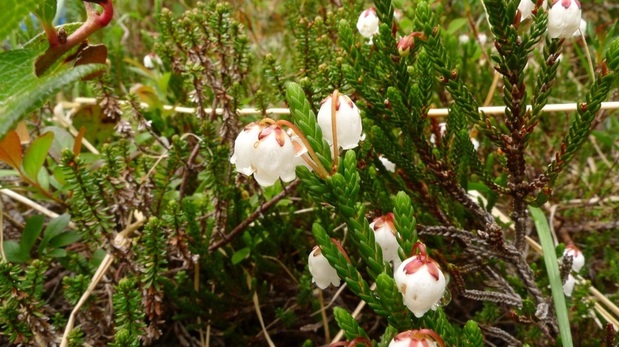White mountain-heather, western moss heather •
Cassiope mertensiana
Identification
White mountain-heather is the most identifiable of the four mountain-heather species that often grow together in BC. Its scale-like leaves have an opposite arrangement along the stem, and its small white flowers are bell-shaped when fully open. This low-lying shrub has stems to 30 cm tall, and often forms large mats.
Habitat & Range
As its name suggests, white mountain-heather is found in open habitats in alpine and subalpine environments. Its range extends along the Pacific coast from Alaska to California, and inland across BC, western Alberta, Washington, Oregon, and Montana.
Similar Species
Club-moss mountain-heather (Cassiope lycopodioides) is very similar to white mountain-heather, except it is smaller, with stems to 2 mm in diameter, compared to the 4 mm diameter stems of white mountain-heather. Club-moss mountain-heather is more common on Haida Gwaii.
Alaskan, pink, and yellow mountain-heather all have similar flowers to white mountain-heather, but their leaves are more needle-like. Crowberry is another species with needle-like leaves, though it has much less flashy flowers.
Human Uses
White mountain-heather can be used to produce a golden-brown dye. It has also been used by the Nlaka'pamux (Thompson) First Nations to treat tuberculosis.
Intriguing Info
White mountain-heather is a very slow-growing species: plants of this small shrub may be up to 20 years old.
iNaturalist
https://www.inaturalist.org/taxa/60530-Cassiope-mertensiana
White mountain-heather is the most identifiable of the four mountain-heather species that often grow together in BC. Its scale-like leaves have an opposite arrangement along the stem, and its small white flowers are bell-shaped when fully open. This low-lying shrub has stems to 30 cm tall, and often forms large mats.
Habitat & Range
As its name suggests, white mountain-heather is found in open habitats in alpine and subalpine environments. Its range extends along the Pacific coast from Alaska to California, and inland across BC, western Alberta, Washington, Oregon, and Montana.
Similar Species
Club-moss mountain-heather (Cassiope lycopodioides) is very similar to white mountain-heather, except it is smaller, with stems to 2 mm in diameter, compared to the 4 mm diameter stems of white mountain-heather. Club-moss mountain-heather is more common on Haida Gwaii.
Alaskan, pink, and yellow mountain-heather all have similar flowers to white mountain-heather, but their leaves are more needle-like. Crowberry is another species with needle-like leaves, though it has much less flashy flowers.
Human Uses
White mountain-heather can be used to produce a golden-brown dye. It has also been used by the Nlaka'pamux (Thompson) First Nations to treat tuberculosis.
Intriguing Info
White mountain-heather is a very slow-growing species: plants of this small shrub may be up to 20 years old.
iNaturalist
https://www.inaturalist.org/taxa/60530-Cassiope-mertensiana
References
Pojar, J. and MacKinnon, A. (2005). Plants of Coastal British Columbia, Revised. Vancouver, BC: Lone Pine Publishing. P. 62.
Cassiope mertensiana (Bong.) G. Don western moss heather. Plants profile. United States Department of Agriculture Plants Database. Accessed 18/03/2013.
Authors and editors of page
Chanda Brietzke, Kelly Fretwell, and Brian Starzomski (2016).
Pojar, J. and MacKinnon, A. (2005). Plants of Coastal British Columbia, Revised. Vancouver, BC: Lone Pine Publishing. P. 62.
Cassiope mertensiana (Bong.) G. Don western moss heather. Plants profile. United States Department of Agriculture Plants Database. Accessed 18/03/2013.
Authors and editors of page
Chanda Brietzke, Kelly Fretwell, and Brian Starzomski (2016).





